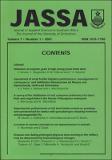| dc.contributor.author | Murwi, W. | |
| dc.contributor.author | Chakoma, C. | |
| dc.contributor.author | Hamudikuwanda, H. | |
| dc.contributor.author | Kusina, N. | |
| dc.coverage.spatial | Zimbabwe. | en |
| dc.date.accessioned | 2016-03-08T14:23:44Z | |
| dc.date.available | 2016-03-08T14:23:44Z | |
| dc.date.issued | 2001 | |
| dc.identifier.citation | Murwi, W. et al., (2001) Reproductive performance of Tuli beef heifers mated as yearlings and synchronised for oestrus with gonadotropin releasing hormone and prostaglandin F2α, Journal of Applied Science in Southern Africa, vol. 7, no. 1, pp. 41-53. Harare: UZ Publications. | en |
| dc.identifier.issn | 1019-7788 | |
| dc.identifier.uri | https://opendocs.ids.ac.uk/opendocs/handle/20.500.12413/9792 | |
| dc.description | A JASSA study to compare the reproductive performance of yearling heifers with that of two year old heifers and to determine whether hormone addition could improve fertility in yearling beef heifers. | en |
| dc.description.abstract | The objective of this study was to compare the reproductive performance of yearling heifers with that of two year old heifers and to determine whether oestrus synchronisation with gonadotropin releasing hormone (GnRH)and prostaglandin F2a(PGF2a) could improve fertility in yearling beef heifers. The experiment was conducted at Grasslands Research Station, Marondera, Zimbabwe from October 1997 to July 1998. Supplementary feeding of 52 Tuli yearling heifers, seven to nine months old, was initiated at the beginning of the experiment. This was done to ensure that the heifers would have attained a target breeding weight of 260 to 300 kg (60 to 65 percent of the mature cow body weight) by 13 to 15 months of age. The yearling heifers and 20 two year old heifers were observed for signs of oestrus starting two months prior to the onset of breeding. At 13 to 15 months of age the yearling heifers weighed on average 265 ± 15 kg. The heifers were randomly divided into two equal groups, and one group was synchronised for oestrus with GnRH (2 ml Receptal® per injection) and PGF2a (1 ml Prosolvin® per injection) given six days later. All heifers then ran with three Tuli bulls over a 60 day breeding period. Blood samples were taken for plasma progesterone concentration determination. The pre-breeding mean interval between oestruses for yearling heifers was longer (21.9 ± 1.6 d vs 17.7 ± 1.0 d; P < 0.05) than for two-year old heifers. Pregnancy rate for yearling heifers was lower (33.3 percent vs 90.0 percent; P<0.001) than that for two year old heifers, but there was no difference (P>0.05) between synchronised and non-synchronised heifers. The results indicated that yearling Tuli heifers showed normal oestrous activity but had lower conception rates than the two year old heifers. In addition, the results showed that reproductive performance of the yearling heifers was not improved by synchronising oestrus with GnRH and PGF2a and that there was little benefit in breeding Tuli heifers below 280 kg body weight. | en |
| dc.language.iso | en | en |
| dc.publisher | University of Zimbabwe (UZ) Publications. | en |
| dc.rights.uri | http://creativecommons.org/licenses/by-nc-nd/3.0/ | en |
| dc.subject | Agriculture | en |
| dc.subject | Science and Society | en |
| dc.subject | Sexuality and Development | en |
| dc.title | Reproductive performance of Tuli beef heifers mated as yearlings and synchronised for oestrus with gonadotropin releasing hormone and prostaglandin F2α | en |
| dc.type | Article | en |
| dc.rights.holder | University of Zimbabwe (UZ) | en |


